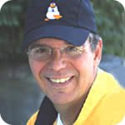 The long road back starts with a single step.
The long road back starts with a single step.
I’ll call him Larry to spare him any embarrassment. Those who know who he is – know. Those who don’t need only know this: in his prime, he ran a marathon in 2:48. That was many years ago and nearly 200 pounds ago. And yet, there we were, on a marathon course, making our way to the finish line.
A year earlier, a mutual friend threw down the gauntlet and asked Larry to confront his weight, which had reached an alarming 330 pounds or more. I promised Larry that if he would lose 100 pounds that I would walk the next year’s marathon with him. At the time it seemed like a promise I would never have to keep.
Within weeks Larry began devising a plan. He developed a strategy of sensible eating and moderate exercise. With the help of Coach Jenny Hadfield, Larry began to get out of the house and walk. Slowly at first. Not far at first. But he walked.
Larry’s progress was staggering and his determination inspiring. Regardless of his work and travel responsibilities, Larry got out there and walked. He walked on beautiful paths, city streets and in circles around motel parking lots. Like his days as an elite athlete, Larry put his training sessions first, and the rest of his life had to fall in place.
I hadn’t seen him in nearly 10 months. I was shocked. 100 pounds is a lot of weight to lose. But even now, Larry hardly looked slim. There was less of him, much less, but still more than he wanted. This marathon was only a milepost, not the final destination.
It’s hard for me to imagine what must have been going through his mind as we lined up for the early, “walkers” start. As a former elite athlete, my guess is that he once viewed the early birds as the giant unwashed masses whose lack of talent was matched only by their lack of understanding of the sport of marathoning. This group is beyond the debate of what it means to run a marathon. For them, it is simply about moving forward one step at a time.
It’s a motley crew back there, and the early morning darkness couldn’t hide that fact that we were surrounded by marathoners who would never be judged fit if body dimensions were all that mattered. For the most part, this was the crowd that would carry the weight of their histories with them on the course.
Larry had a plan, as would any elite athlete. He had a time goal, a hydration and refueling plan and mileage markers where he would reassess those goals. But more importantly, Larry had a vision. He saw himself crossing the finish line. He saw himself racing for the first time in 17 years. The competition was vastly different for him on this day. His former peers would finish hours ahead of him, but Larry would, at last, outrun the demons that had haunted him.
By the time we got to mile 14 the course was already beginning to close. The water tables were coming down, the police were asking us to move to the sidewalk, and it dawned on Larry that he had never experienced the true back of the pack. He was astounded by what he saw. Unlike the well-supported pack of elites, with special fluids and press trucks and VIP treatment, he was now one of the forgotten.
Abandoned by the race, abandoned by his racing colleagues, Larry soldiered on. Somewhere around mile 17, I watched the transition come over him. We were now moving at about an 18-minute per mile pace. His first time goal was out of reach. His worst case time goal was slipping away. The truth hit him. This was going to be the most difficult day of his athletic career.
In that moment, the elite athlete, for so long hidden behind the weight and responsibilities, burst through to the surface. Larry’s stride, which had begun to weaken, grew suddenly strong again. The fire of competition was burning as brightly as if he were in a battle for the lead. He dug in, he dug down, he leaned into the challenge with the fierceness of a warrior.
As we turned the final corner and saw the finish line, Larry’s eyes (and mine) began to fill with tears. The race organizers had stretched the tape across the finish line for him to break. The clock was still running, and a handful of dedicated volunteers had stayed to wait for him.
The announcer called out his name, and again Larry’s pace quickened. This was the final push. This was when he would let it all hang out, put everything he had left on the line, when he would reach for the final measure of himself.
So it was that he crossed the finish line eight hours and 43 minutes after he started. Six hours longer than his personal best at the same distance, Larry finished with more pride, more satisfaction, and more hope than he had ever experienced. He was on the comeback trail. And there was no turning back.
Waddle on, Larry…








